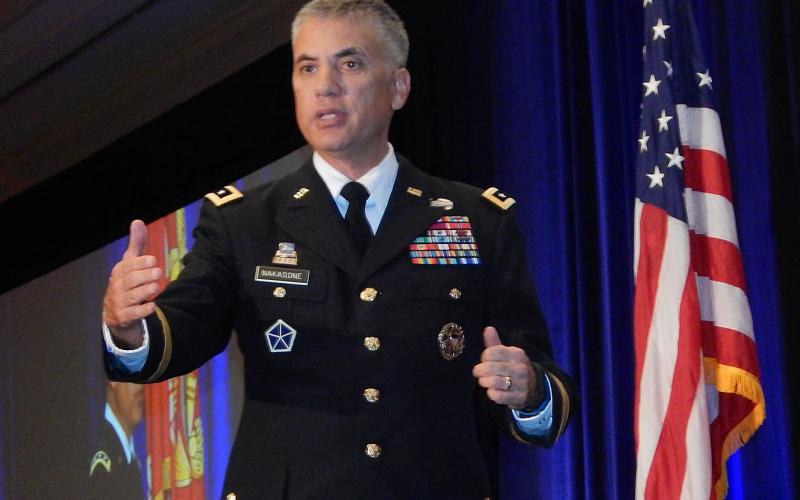 Cyber, robots, artificial intelligence and other technologies will define the multidomain battlefield.
Cyber, robots, artificial intelligence and other technologies will define the multidomain battlefield.
On the multi-domain battlefield of the future, U.S. forces can expect to see more robots, pilotless ships and planes, and driverless convoys, as well as cyber and other game-changing capabilities, said Lt. Gen. Paul Nakasone, USA, commanding general, U.S. Army Cyber Command.
Gen. Nakasone made the comments during the afternoon keynote address at AFCEA TechNet Augusta 2017 in Augusta, Georgia.
“We are witnessing a fundamental change and transformation in the character of war," he said. “This transformation is being driven by technology and demographics, socioeconomic and political changes.”
The general compared the changes to those made during World War I, which transformed warfare for the 20th century, just as cyber and other technologies are doing for the 21st century. “To succeed on the future battlefield will require our Army and the joint force to adapt how we fight in response to these changes. Military history is filled with examples of armies that adapted their tactics in response to change, and quite frankly, those armies that did not,” Gen. Nakasone said.
Technology has always driven change, he pointed out, but the pace of change today is far different than in previous warfighting eras. In addition, the proliferation of inexpensive technologies means sophisticated capabilities are now widely available. “Think about it—robots, artificial intelligence, supercomputing and other emerging technologies will continue to push new boundaries and new revolutionary capabilities,” Gen. Nakasone said. “On the multidomain battlefield of the future, we can expect to see more robots, pilotless ships and planes, and driverless convoys.”
Unfortunately, Gen. Nakasone said, the U.S. may not have an advantage in any single domain. “Nowadays, I would say American superiority in any domain against a peer or near-peer adversary can certainly not be guaranteed,” he said.
On the battlefield of the future, an adversary would likely employ anti-access/anti-denial capabilities before Navy ships even sailed or Air Force transport planes could leave their bases, he warned, and those ships and planes likely will be tracked from space.
Furthermore, enemy cyber attacks likely will be launched to disrupt U.S. military electronic systems before any kinetic operations even begin. Battle for air and sea control would commence hundreds of miles from any landing area, and barrages of missiles would attempt to defeat naval and air forces. Air drops would be futile. And drones overhead would film the destruction in an attempt to control the narrative, he said, painting a dire picture.
“Finally, we should anticipate cyber attacks, not only cyber attacks in an area of conflict but against the homeland, certainly against our critical infrastructure and key resources,” he predicted.
He cited Russia’s aggression against Ukraine and Georgia as examples. “Ukraine appears to be serving as a testing ground, a virtual training center, some might call it for a well-resourced cyber actor,” he said.
While adversaries continue to hone their cyber skills, the U.S. Army and the joint force must be prepared to fight and win on a multidomain battlefield, he stated. That begins with aggressively defending U.S. networks, ensuring mission command and protecting critical weapon systems and the integrity of data. It also includes delivering cyberspace effects against adversaries and integrating cyber capabilities across all domains, the general elaborated.
“Protecting and defending cyberspace, and exploiting electromagnetic spectrum will be key to overcoming anti-access and anti-denial strategies of our adversaries,” he said. “The success of the CEMA [cyber electromagnetic activities] concept relies on integrating the cyber, electromagnetic, electronic warfare, information force in the future.”
Such nonlethal effects must be coordinated and synchronized within the joint force scheme of maneuver and used to disrupt enemy mission command, influence populations and deceive or disrupt enemies, he said.
He also stressed the importance of quantum computing and artificial intelligence to the future force.
Asked about the WannaCry ransomware, the general voiced concern that other capabilities stolen from U.S. agencies could be used against us. “As I look at the future, one of the things that does concern me is the vulnerabilities that have been stolen … from a number of our different intelligence community partners that could well become the next vulnerabilities weaponized for us to deal with tomorrow,” he said.
The commander also pointed out that demographics are rapidly changing. Megacities—those cities with populations above 10 million—are expected to double in the coming years, making urban warfighting much more likely. “Frankly, the future fight looks a lot more like Falluja than it does like Fulda,” Gen. Nakasone said.
Combat in a megacity presents many unique challenges, many of which the military witnessed during the battle to clear ISIS from Mosul, Gen. Nakasone offered, adding that “block after city block was leveled with over 10,000 buildings destroyed as Iraqi routed ISIS from the city” and that “hundreds of thousands of civilians were forced to flee as a result of the fighting.”
Furthermore, coalition and ISIS drones dotted the skies collecting intelligence and searching for targets, he reminded the audience. “Mosul clearly illustrates to me many of the challenges when operating in a dense, interconnected and complex urban environment,” Gen. Nakasone stated. “Fighting in a megacity, which is three to four times the size of Mosul will be unlike anything we’ve faced before.”
And civilian populations in those megacities will add to the complexity. “With millions of civilians armed with cellphones and security cameras everywhere, large formations will be easily observed. Bandwidth will be in short supply with our communications contested, congested and certainly competitive,” he offered.
As a result of the challenges, U.S. formations will need to be “smaller, more agile, dispersed and better networked.”
No comments:
Post a Comment